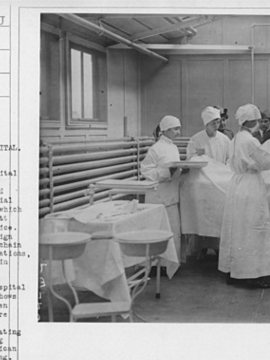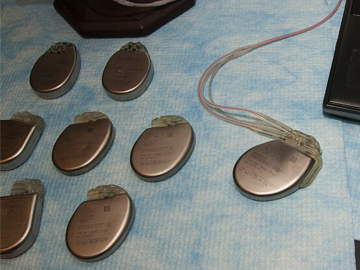Most ear issues lean toward vertigo and hearing loss, and doctors will not diagnose a patient with Ménière’s disease unless they experience both. Before my diagnosis, I thought hearing loss meant gaining silence. Since my diagnosis, I’ve gained noise.
It’s my cochlea in the inner ear, shaped like a common spirula shell or a Cuban brown snail shell. The cochlea’s function is to change the vibrations from the middle ear into nerve signals that travel to the brain so that we can hear. My ear falters there, in the tiny hairs of the cochlea[i], and the noise I hear every day sounds as if I were holding up a gigantic shell to my ear: a queen conch or a Triton’s trumpet. You may imagine I’m René Magritte’s Shell in the form of an ear (Untitled), a surrealist painting of a gigantic ear-shell shaped like a Triton’s trumpet. Alone on a beach with its impossible size, the ear-shell is completely out of place, so cavernous. I am bereft at the enormity of its sucking-in of all that air, ripe with an uproarious swish of seagulls, which are clearly there but out of frame. When I look at the painting I can hear the absent presence of the seagulls, and they’re loud.
*
There’d be no noise to contend with on the moon because we’d all be profoundly deaf. You can’t hear on the moon, the atmosphere’s all wrong. To hear, we need the vibrations of Earth’s air, it’s cycles of condensation and rarefaction. Each cycle is called a Hertz, the lowest note on a piano being 4,186 Hz while the highest is 27. Most human capacity for hearing lies between 20 to 20,000 Hz so most people can hear a piano’s scale, though on the moon, pianos would be obsolete.[ii] I would miss them. I would miss music. But there’s this: if every survivor of our Earth’s apocalypse made it to the moon, we’d all go deaf together, which means we’d all have to learn sign language, and maybe that would make up for the deprivation of music because instead of dancing to music, we’d be dancing to a silent language, and wouldn’t that be beautiful!
*
In Sean Williams’s book Impossible Music, a young man named Simon wakes up in the middle of the night to find he can’t hear a thing: ‘Silence has pressure and weight. It grinds you down, and I suppose that could have been what woke me.’[iii] He’s a musician and composer for whom music is identity-making and confirming. It’s his past, his present and was going to be his future. In trying to bring silence and music together, in trying to keep his identity from completely shattering alongside his hearing, he refers to musical theorist John Cage, who said, ‘Every something is an echo of nothing.’ Simon asks, ‘What if nothing is the whole point, and the something only gets in the way?’[iv]
In an address to the convention of the Music Teachers National Association in 1957, John Cage also said this:
There is no such thing as an empty space or an empty time. There is always something to see, something to hear. In fact, try as we may to make a silence, we cannot. For certain engineering purposes, it is desirable to have as silent a situation as possible. Such a room is called an anechoic chamber, its six walls made of special material, a room without echoes. I entered one at Harvard University several years ago and heard two sounds, one high and one low. When I described them to the engineer in charge, he informed me that the high one was my nervous system in operation, the low one my blood in circulation. Until I die there will be sounds. And they will continue following my death. One need not fear about the future of music.[v]
Music as silence, silence as music.
*
I can’t relate to Simon from Impossible Music. I don’t understand silence. Rather I identify with his girlfriend G, who has a vexing form of tinnitus that’s resulted in extreme hearing loss. It’s not only about phantom noises whirring on and on, but also an inability to compartmentalise hearing, an inability to filter out background noise and focus on the foreground. It’s a cluttered cacophony that fills a space so demandingly one gets used to nodding, as if they can catch the words flung in their direction when really there’s no hope at all. At parties, pubs and restaurants it’s unfeasible someone with this type of hearing loss will ever be fully invested in any conversation. The painter David Hockney called it ‘noise pollution’ and it drove him away from art exhibitions, though on the flip side he claimed his hearing loss made his painting sharper: ‘I think my going deaf increased my spatial sense, because I can’t get the direction of sound. I feel that I see space very clearly, and that’s because I can’t hear it.’[vi] This led to vivid English landscapes with the same distinctive, almost animative style of his Los Angeles swimming pool paintings of the 60s and 70s, but these had a Van Gogh feel. Hence the Hockney – Van Gogh exhibition in 2019 called Two Painters, One Love. Noise pollution can result in exquisite works of art.
*
Beyond exhibition openings, parties, pubs and restaurants to remote areas littered with multiple slow-turning blades of wind turbines, noise pollution is everywhere. It even infiltrates our oceans. In the underwater world, right whales are losing their hearing because of it and can no longer communicate as they once could with other right whales, which means they can’t find each other so easily. More and more they’re spending time on their own.[vii]
*
In 1929 René Magritte moved to France, where he met his great friend and rival Salvador Dali. Together they would define Surrealism by painting interpretations of their dreams (Magritte said, ‘If the dream is a translation of waking life, waking life is also a translation of the dream’).[viii]
After meeting Pope Pius XII at a private gathering, Dali declared himself a Catholic and began experimenting with the image of the Virgin Mary in his paintings. Two of those paintings strike me deeply and I consider them companions: Madonna – a rendition of Raphael's Sistine Madonna situated in a gigantic ear – and the beguilingly titled Van Gogh’s ear cut dematerializing from its frightening existentialism and exploding in the manner of a pion during the dazzling of Raphael’s Sistine Madonna (sometimes shortened to Cosmic Madonna), in which another rendition of the Sistine Madonna is key. Was Catholicism, which he’d rejected for the first half of his life, whispering in his ear? Or was it the madness of Vincent van Gogh? Or was it the notion of ‘ear’?
*
Some might say the myth of Van Gogh’s severed ear is greater than his art, though I am not one. Sugababe is a work in which Van Gogh’s ear has become a work of art. Dutch artist Diemut Strebe began with a 3D bioprinting in the shape and size of Van Gogh’s ear, using a dissolvable sugar-polymer scaffolding which she injected with the living cartilage cells of Lieuwe van Gogh, the great-great-grandson of Vincent’s brother, Theo. For several weeks the ear nested inside a bioreactor, and eventually the scaffolding dissolved while the cells thrived. The ear, with one-sixteenth of the same genes as Vincent van Gogh and living in a nutrient-rich solution, is alive.[ix]
125 years after the artist severed his left ear, Strebe has grown it back, and it can hear. If you speak to it through a microphone, the sound will travel to a computer processor that simulates nerve impulses. Noam Chomsky was the first person to speak to the ear, and when he stopped talking, the ear crackled back at him, the feedback being a response to silence, not words. Chomsky was therefore hearing an ear hearing silence, which goes to show silence is never silence. [x]
*
By the age of twelve, lover of musical instruments Evelyn Glennie had become profoundly deaf, so she took up percussion. With drums, she could still hear the music because she could feel the music. Incredibly gifted and determined, Glennie became the first person to successfully establish and maintain a full-time career as a solo percussionist. ‘My career and my life have been about listening in the deepest possible sense,’ she writes. ‘Losing my hearing meant learning how to listen differently, to discover features of sound I hadn’t realized existed. Losing my hearing made me a better listener.’[xi]
Glennie performed on the soundtrack of The Sound of Metal – a stark and poignant film about a heavy metal drummer losing his hearing – and interviewed the film’s star, Riz Ahmed, for The Evelyn Glennie Podcast. They talked drumming and listening and Deaf culture, and so often the three were inseparable. When she asked him if he’d learned anything that he’ll take away with him, that’s transformed him in any way, his answer was thus:
I feel the Deaf community taught me the true meaning of listening. You know, listening is so different from hearing. Hearing is a physical sense; it’s a biological process. Listening is something to do with your attention and your energy, and where you place it, and how you hold space for someone else’s energy with your attention. It’s much more – it’s an act of absorption, of osmosis. It’s a meditative act … at times a kind of spiritual act …. it’s about… removing a barrier between yourself and the other, I think. It’s most profound.[xii]
I imagine Glennie nodding her head vigorously. She has long-maintained we hear with the whole body; the whole body can hear.
*
René Magritte’s The White Race is a painting of a bathing nude, brassy and bold in composition, where each body part is a definitive shape. The thighs are like bell pumpkins nesting in the sand, the belly a perfectly round birthing-circle, the smaller circles above it also exact, these ones breasts. On top of those breasts it gets really interesting. Two noses act as columns holding up a pair of lips. Making a maybe-neck of the bathing nude, the noses with the red lips also make a retro table, straight out of 1937. Upon that table, atop of those lips, is an ear, centralised as a nose would be on a non-misshapen face. The ear balances a single eye, the eye the apex of the bathing nude. I wonder about ear-as-nose. I wonder about ear-as-centre-of-face. Of course I am concentrating on the ear, and now I am breathing in through my nose and imagining it’s an ear. Suddenly I want my left ear to be the centre of my face. I want to hear with my whole face; I want my whole face to hear.
*
In The Sound of Metal, Ruben Stone is losing his hearing. He plays drums in a heavy metal duo with his partner, Lou, so there’s a lot at stake. (If you’re losing your hearing – if you’re losing anything – there is always a lot at stake.)
Ruben’s a heroin addict, clean for four years, so going deaf could destroy his sobriety. Knowing this, he goes to a house for Deaf addicts, where he’s first told to wake up early, grab a coffee and a doughnut and go into the house leader’s empty study and sit. If sitting bores him, he can write. When Ruben walks into the study, the pen and paper on the otherwise bare wooden table is so confronting he smashes the doughnut, screams, pounds, laughs in a way that isn’t funny. He calls himself a fucken idiot. He can’t accept what the house leader is trying to gift him: moments of quiet.
*
I can no longer ‘just sit’. I get lost in my head, in my ear. It’s mostly fear and all that noise. You see, I haven’t lost my hearing, I’ve lost my silence, and losing my silence means I’ve gained noise and that noise is making me lose my hearing, so I lie.
*
I have a special relationship with my ear that’s multifaceted. It’s melancholy and desperate, which is why I’m deeply attached to Van Gogh’s Self-Portrait with Bandaged Ear, a painting he made a week after he left hospital for treatment of the psychotic episode that had forced a razor into his hand and urged him to slice off his ear. When I look at the painting, I see a man who’s mighty low, cold in his own home, a fur-lined winter cap and heavy coat buttoned at the collar. The bandage protecting the area where his left ear had been a constant reminder of just how fragile he is in this world, a visual that would trigger sadness and dread, which he must sit with.
Diemut Strebe photographed Lieuwe van Gogh after his DNA procedure for Sugababe and also called it Self-Portrait with Bandaged Ear. Lieuwe has ginger hair and piercing blue eyes and clearly resembles his great-great-great uncle. Around the left side of his face is a modern-day white cup-and-strap bandage protecting his ear. He looks away from his would-be viewers, as does Vincent in his own self-portrait, and it’s as if the young Van Gogh is being haunted by an old trauma, perhaps one that happened more than a century ago. I see Lieuwe. I see Vincent. I see my ear.
[i] Ryugo, David. Hearing and Brain - Making Sense of Sound and Hearing Loss. Sydney
Meniere’s Support Group, 8 November 2021. Webinar
[ii] ibid
[iii] Williams, Sean. Impossible Music. Allen&Unwin. Sydney, 2019. (p27)
[iv] ibid (p82)
[v] Cage, John. ‘Experimental Music.’ Printed in the brochure accompanying George Avakian’s
recording The 25-Year Retrospective Concert of the Music of John Cage at Town Hall. New York, 15
May 1958.
[vi] Hockney, David. ‘On Deafness.’ UnHerd. 21 June 2021. https://unherd.com/2021/06/on-deafness/ Accessed 21 November 2021.
[vii] Biguenet, John. Silence. Bloomsbury Academic. New York, 2015. (p113)
[viii] Magritte, René qtd in ‘Dalí and the Surrealist Group in Paris.’ Dalí Universe. 25 April 2018. https://www.thedaliuniverse.com/en/news-dali-and-the-surrealist-group-paris Accessed 16 November 2021.
[ix] Strebe, Diemut. Self-Portrait with Bandaged Ear. 2012. Digital C-print mounted on Dibond. http://diemutstrebe.altervista.org/ Accessed 23 November 2021
[x] Blakemore, Erin. ‘This Ear Was Made With Vincent Van Gogh’s DNA.’ Smithsonian Magazine. 10 November 2015. https://www.smithsonianmag.com/smart-news/this-ear-made-with-van-gogh-dna-180957230/ Accessed 23 November 2021.
[xi] Evelyn Glennie: Teach the World to Listen. https://www.evelyn.co.uk/about/biography/ Accessed 16 June 2021
[xii] Glennie, Evelyn, narrator. ‘Ahmed, Riz.’ The Evelyn Glennie Podcast. Evelyn Glennie Teach the
World to Listen, 16 June 2021. https://www.evelyn.co.uk/theevelynglenniepodcast/
Image via Mike Peel (Public domain)


